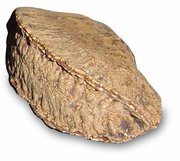Brazil Nut
|
|
| Brazil Nut | ||||||||||||||
|---|---|---|---|---|---|---|---|---|---|---|---|---|---|---|
| Missing image Brazil_Nut_fruit.jpg Brazil Nut Brazil Nut fruit | ||||||||||||||
| Scientific classification | ||||||||||||||
|
The Brazil Nut is a South American tree Bertholletia excelsa in the family Lecythidaceae; it is the only species in the genus Bertholletia. It is native to Guiana, Venezuela, Brazil, eastern Colombia, eastern Peru and eastern Bolivia. It occurs as scattered trees in large forests on the banks of the Amazon, Rio Negro, and the Orinoco. It is a large tree, reaching 30-45 m tall and 1-2 m trunk diameter, among the largest of trees in the Amazon Rainforests. The stem is straight, and commonly unbranched for well over half the tree's height, with a large emergent crown of long branches above the surrounding canopy of other trees. The bark is grayish and smooth.
Bertholletia_excelsa.jpg
The leaves are dry-season deciduous, alternate, simple, entire or crenate, oblong, 20-35 cm long and 10-15 cm broad. The flowers are small, greenish-white, in panicles 5-10 cm long; each flower has a two-parted, deciduous calyx, six unequal cream-colored petals, and numerous stamens united into a broad, hood-shaped mass.
The fruit takes 14 months to mature after pollination of the flowers, and is a large capsule 10-15 cm diameter resembling a coconut in size and weighing up to 2 kg. It has a hard woody shell 8-12 mm thick, and inside contains 8-24 triangular seeds 4-5 cm long (brazil nuts) packed like the segments of an orange; it is not a true nut in the botanical sense. The capsule contains a small hole at one end, which enables large rodents like the Agouti to gnaw open the capsule. They then eat some of the nuts inside, but bury others for later use; some of these are able to germinate to produce new Brazil Nut trees.

Despite their name, the most significant exporter of brazil nuts is not Brazil but Bolivia, where they are called almendras. In Brazil, these nuts are called castanhas-do-ParŠ, literally "chestnuts from ParŠ". Indigenous names include juvia in the Orinoco area, and capucaya in Brazil. The genus is named after the French chemist Claude Louis Berthollet.
Nutritionally, brazil nuts are an excellent source of selenium and a good source of magnesium and thiamine. They are 14% protein, 11% carbohydrates, and 67% fat. The fat breakdown is roughly 25% saturated, 41% monounsaturated, and 34% polyunsaturated. The saturated fat content of brazil nuts is among the highest of all nuts, surpassing even macadamia nuts. Because of the resulting rich taste, brazil nuts can often substitute for macadamia nuts or even coconuts in recipes. The high fat content of the nuts results in their not keeping well, and particularly shelled brazil nuts soon become rancid. The nuts are also pressed for oil; as well as for food use, brazil nut oil is also used as a lubricant in clocks and for making artists' paints.
Effects of harvesting
Brazil nuts for international trade come entirely from wild collection rather than from farms. This has been touted as a model for generating income from a tropical forest without destroying it.
Analysis of tree ages in areas that are harvested show that moderate and intense gathering takes so many seeds that not enough are left to replace older trees as they die. Sites with light gathering activities had many young trees while sites with intense gathering practices had hardly any young trees.
Statistical tests were done to determine what environmetal factors could be contributing to the lack of younger trees. The most consistent effect was found to be the level of gathering activity at a particular site. A computer model perdicting the size of trees where people picked all the nuts matched the tree size data that was gathered from physical sites that had heavy harvesting.
See also
References and external links
- Template:Journal reference issue
- Brazil Nut homepage (http://www.bertholletia.org/bertholletia/)Template:Commonscat
da:ParanÝdder de:Paranuss pt:Castanha-do-ParŠ fi:Parapšhkinš

